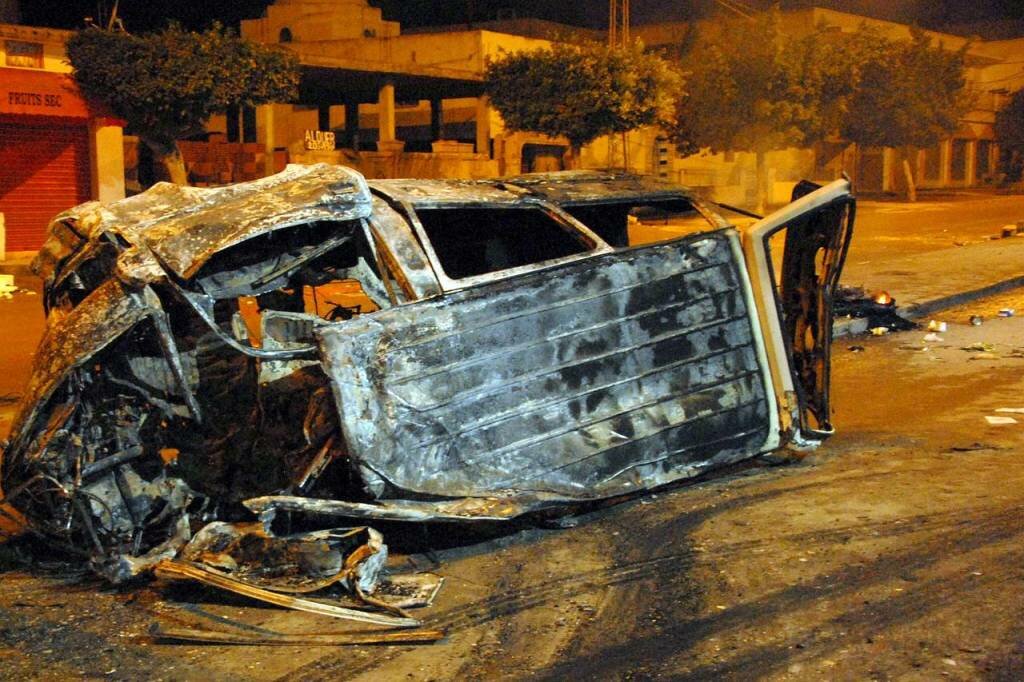Protests coinciding with Arab Spring anniversary lead to looting and destruction, with Tunis now the focal point

A picture taken on Thursday shows a burnt car on a street in Ettadhamen city, west of the Tunisian capital, following a wave of protests and clashes which have brought fresh crisis to the country, five years on from the Arab Spring. PHOTO: AGENCE FRANCE-PRESSE/GETTY IMAGES
Tunisia imposed a nationwide curfew Friday as protests that coincide with the Arab Spring anniversary spread from the nation’s impoverished heartland to the capital, leading to looting and property destruction.
The indefinite curfew, announced by the interior ministry and scheduled to take effect at 8 p.m. local time Friday evening, comes after five days of protests in several cities over widespread unemployment.
The unrest has surfaced around the five-year anniversary of similar demonstrations that drove out Tunisia’s longtime autocratic president, triggering similar protests that removed other long-serving leaders across the Middle East in a movement known as the Arab Spring.
This week’s fast-moving demonstrations underscore the difficulties Tunisia has faced addressing basic economic needs since 2011. Despite establishing an inclusive democracy that is hailed as a rare political success story for the region, Tunisia now faces fresh unrest that stems from a stagnating economy.
Sunday’s protests broke out after a young man in the working-class city of Kasserine killed himself, apparently despondent over being rejected from a list of jobs at the education ministry. Police responded to a sit-in at the city council with tear-gas, prompting demonstrations to grow, said Rabii Gharsalli, an activist based in the city.
In its haste to quell the unrest, the government of Prime Minister Habib Essid announced emergency measures on Wednesday, with 5,000 new jobs promised in Kasserine and surrounding towns. The following day, the minister of finance said the announcement had been made in error and that 5,000 unemployed people would be given job training.
The apparent error further infuriated residents, according to Mr. Gharsalli, who said “people felt betrayed.”
The demonstrations spread to neighboring towns and on Thursday to poor districts in the capital, Tunis, where they turned violent and destructive, witnesses and the interior ministry said. One police officer was killed earlier this week in a car accident while responding to rioting and 20 people have been arrested for violence during protests, the ministry said.
For many Tunisians, this round of demonstrations bears strong resemblance to the 2011 protests, which erupted near Kasserine. The latest unrest also comes at a sensitive time for President Beji Caid Essebsi, a career politician who held prominent positions under successive autocratic regimes.
Mr. Essebsi won election in 2014 after campaigning as an elder statesman capable of restoring prosperity to Tunisia. However his party, Nidaa Tunis, has seen multiple lawmakers defect over suggestions that he was grooming his son to take over—threatening the party’s plurality in parliament and once again putting the Islamist Ennahda party in a dominant position.
These internal party disputes were preceded by two major terrorist attacks on tourists in 2015 that were later claimed by Islamic State.
Mr. Essebsi urged calm this week, saying the demonstrations are constitutionally protected but violence wouldn’t be tolerated.
Unemployment in Tunisia has risen to 15% from 13% before the revolution, with the rate spiking to 30% among young people. Moody’s this week issued a report in which forecasts for growth were cut to 1.5% in 2016 from a forecast of 2.3%. Tourism receipts had plummeted 35% by the end of 2015 compared the same period a year earlier, according to Moody’s.
Amine Ghali, a political analyst and the director of the Tunis-based Al Kawakibi Center for Democratic Transition, said this week’s demonstrations will put further pressure on the government to focus on the economy but they are not likely to cause the administration’s collapse.
“Even if [there is a feeling of] déjà vu, it is still different from 2011 since it has no political motives. It is purely economic,” he said. “People are aware it has to be solved in the quickest way possible with urgent economic measures that send hope.”





